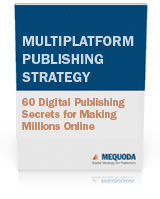It’s Time to Succeed in Multiplatform Publishing
Build your digital publishing empire with our Multiplatform Publishing Handbook
We hate spam as much as you do. You have our promise not to sell or share your email address, ever! Please read our Privacy Policy.
Dear Publishing Colleague,
Where were you in your publishing career a decade or so ago?
Were you excited about the Internet and its impact on our industry? Did you see a clear path forward, on your way to making millions in digital magazine publishing? Probably, like most publishers, you felt both optimism … and fear.
I hope you succeeded in mastering the Internet. I know most publishers did not – at least not yet. And today, much to our surprise, we have an even bigger challenge: the new world of digital publishing.
I’m Don Nicholas, and I’ve spent 30 years in the magazine publishing industry. Starting in 1997 I was busy turning my career as a consultant to print publishers into expertise for the Internet age. Based on my own experience, and extensive research into what was working for my clients, I published my book, Internet Marketing Strategy for Publishers, in 2004.
It was groundbreaking at the time, and has been downloaded some 50,000 times since then.
More than 10 years and one tablet revolution later, my newest professional goal is simple: To help each and every publisher successfully cross the new, digital divide.
And it’s time for an update of my groundbreaking 2004 book, and this is it: Multiplatform Publishing Strategy: 60 Digital Publishing Secrets for Making Millions Online.
You can buy it at Amazon if you’re not ready to be a Mequoda subscriber, of course, but I think you’ll see that free is a much better option!
Why you can count on this book as your multiplatform publishing guide
My company, Mequoda Group, is an acknowledged leader in developing digital publishing solutions. We’ve spent many years perfecting them and helping digital publishers achieve unprecedented success, even when many digital publishing companies are still struggling. In that time …
- My team has spent thousands of hours researching and documenting the most successful strategies and processes.
- We’ve broadened our case study background from a few dozen to more than 100 publishers who use what we call the Mequoda Method to make millions online.
- We’ve added to our research the added value of knowledge from having actually helped hundreds of media brands achieve profitability.
We hate spam as much as you do. You have our promise not to sell or share your email address, ever! Please read our Privacy Policy.
- We’ve published dozens of free books and reports that were downloaded more than 1,000,000 times last year.
- We’ve developed one of the leading newsletters on the topic of multiplatform publishing strategy and digital publishing.
- We’ve refined our digital publishing strategies, expanded the platforms and fine-tuned the reporting tools.
All of this has gone into my newest book. It delivers a proven, integrated set of business processes, principles and tools for the digital publisher, whether you’re B2B, consumer, local, regional or national; multi-title or single.
How niche publishers like you can take advantage of multiplatform publishing
Multiplatform Publishing Strategy: 60 Digital Publishing Secrets for Making Millions Online documents a seismic shift of historic proportions in our industry. You may be contemplating your own path into digital publishing and feeling a bit like Dorothy stepping over the threshold into Oz!
But my team and I have carefully organized what we’ve learned in digital publishing – and we’ve had the privilege of working with some of the biggest publishers in the world.
More importantly, however, we often work with independent digital publishers, and they are some of the most innovative publishers on the planet. You may think you’re not a big enough company to take advantage of digital publishing. But when you read my book, you’ll see that it’s the smaller, more nimble, ambitious digital publishing companies that make the most of the Mequoda Method. And you could be next.
After all, technology has made the tools you need more affordable than ever before, and smaller size is to your advantage for the first time in history. Meanwhile, the mega-publishers are stumbling along as rapidly as they can, afraid they’ll be left behind.
In short, don’t sit out the digital publishing revolution because you think it’s beyond you. Read Multiplatform Publishing Strategy: 60 Digital Publishing Secrets for Making Millions Online, and you’ll see exactly what I mean.
We hate spam as much as you do. You have our promise not to sell or share your email address, ever! Please read our Privacy Policy.
Indeed, while much of the publishing industry continues to struggle to harness the power of the Internet, Mequoda has helped a large and diverse range of publishers succeed in ways others can only imagine.
Their secrets become yours when you read Multiplatform Publishing Strategy: 60 Digital Publishing Secrets for Making Millions Online.
I hope you thoroughly understand why niche publishers like you should waste no time in making the transition to digital publishing. And while my team and I can only personally guide a limited number of clients, we hope that Multiplatform Publishing Strategy: 60 Digital Publishing Secrets for Making Millions Online will help thousands – including you. Because no one should be left behind in the digital publishing revolution!
A complete set of principles for running a successful multiplatform publishing company
Now is the time to learn from what some describe as the industry’s most comprehensive set of multiplatform publishing strategies and leverage them to make millions. When you read my new book, you’ll discover how to drive traffic, turn casual visitors into an engaged audience, and finally to sell you content products in multitudes you’ve never imagined before.
You’ll learn how to uncover assets you didn’t know you had.
You’ll discover which platforms serve different members of your audience best.
You’ll learn how to systematically recycle your original content to satisfy both your readers and your bottom line.
You’ll find out how to drive traffic to your website organically, a strategy which surprisingly few publishers have mastered.
You’ll know how to hire the best and most efficient multiplatform publishing team.
And you’ll learn new strategies for your content, brand and revenue generation that will help you make millions in digital publishing – as it already has for dozens of publishers we’ve already helped, including …
- Computerworld
- Consumer Reports
- Eating Well
- Fine Gardening
- Men’s Health
- Morningstar
- Real Simple
- The Motley Fool
- Yankee Magazine
… to name just a few of the brands we’ve helped.
We hate spam as much as you do. You have our promise not to sell or share your email address, ever! Please read our Privacy Policy.
How to get Multiplatform Publishing Strategy: 60 Digital Publishing Secrets for Making Millions Online
Taking the first step toward multiplatform publishing and digital publishing success is easy. Simply sign up today as a Mequoda Daily subscriber, and you’ll immediately get this book as a free PDF. That’s a $97 value!
(Bonus: You’ll be joining more than 12,000 subscribers who get our continually-updated, proven advice, guidance and strategies every day.)
Why am I giving away this book? Ah, that’s one of the secrets you’ll learn when you read it!
Of course, if you’re not ready to join those other subscribers in gaining digital publishing mastery day by day, you can also buy my book at Amazon. Either way, you’ll be taking a critical step in succeeding where so many others have failed. And you’ll be prepared to successfully make the leap across the digital divide.
So I urge you not to wait. Every day, we hear stories of challenges in the magazine publishing industry … ad revenues dying, subscribers disappearing, print products eliminated. I don’t want you to be one of those stories.
Read Multiplatform Publishing Strategy: 60 Digital Publishing Secrets for Making Millions Online now, and join the ranks of millionaire publishers starting tomorrow.
Best regards,

Don Nicholas
CEO, Mequoda Group
PS: Our clients pay handsomely to gain access to the Mequoda consulting team’s expertise. But when you read Multiplatform Publishing Strategy: 60 Digital Publishing Secrets for Making Millions Online, you get the complete outline of our proven methods all in one place, to read and reference any time you need it.
PSS: Remember, as I explained above, multiplatform publishing is the perfect opportunity for independent publishers to capitalize on the digital publishing revolution. This is a time in history that you can’t afford to let pass you by. Download my book right now, so you can get started building your digital publishing empire today.
We hate spam as much as you do. You have our promise not to sell or share your email address, ever! Please read our Privacy Policy.
The post The Multiplatform Publishing Strategy Handbook appeared first on Mequoda Daily.

 According to one leading industry analyst, the best digital publishing strategies are built on innovation and classic tactics
According to one leading industry analyst, the best digital publishing strategies are built on innovation and classic tactics For digital publishing companies looking to stay on top of trends, a handful of new articles on Digiday will help
For digital publishing companies looking to stay on top of trends, a handful of new articles on Digiday will help






